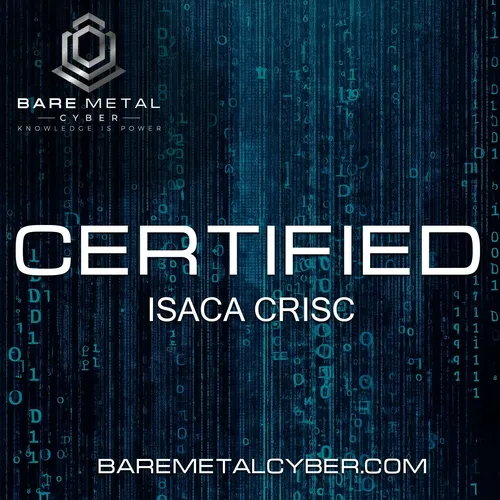
Certified: The CRISC Audio Course
The Bare Metal Cyber CRISC Audio Course is a comprehensive audio training series designed to help you master the CRISC certification with confidence. Each episode delivers in-depth coverage of ISACA’s CRISC domains — from risk governance to monitoring — using a uniquely structured, exam-focused format built for long-term retention. Whether you're studying on the go or doing a deep review, this prepcast is your essential guide to IT risk success.
- Update frequency
- every day
- Average duration
- 11 minutes
- Episodes
- 93
- Years Active
- 2025

Episode 33: Conducting Business Impact Analysis (BIA)
Business impact analysis helps prioritize what matters most during risk assessments. In this episode, you’ll learn how to conduct a BIA, identify critical processes, estimate financial and operationa…

Episode 32: Risk Analysis Methodologies and Tools
Choosing the right methodology is crucial for valid risk assessments. This episode explores the different approaches to risk analysis—qualitative, quantitative, and hybrid—and introduces common tools…

Episode 31: The IT Risk Register: Creation and Management
The risk register is the heart of risk tracking and reporting, and CRISC candidates must understand how to build and maintain one effectively. This episode explains how to document risk scenarios, as…

Episode 30: Risk Assessment Concepts, Standards, and Frameworks
ISACA expects CRISC candidates to understand key risk assessment standards and apply them in context. In this episode, we explore qualitative vs. quantitative methods, the role of standards like ISO …

Episode 29: Risk Scenario Development
Risk scenarios bring all elements of risk together—threats, assets, vulnerabilities, and business impact. This episode walks you through the process of constructing risk scenarios that are measurable…

Episode 28: Vulnerability and Control Deficiency Analysis (Root Cause Analysis)
Risk is driven not just by threats, but also by internal weaknesses. In this episode, we cover how to analyze vulnerabilities and control deficiencies using techniques like root cause analysis. You’l…

Episode 27: Threat Modelling and the Threat Landscape
Effective risk assessment starts with a clear picture of your threat environment. This episode teaches you how to conduct threat modeling, understand adversary types, and anticipate threat behaviors.…

Episode 26: Analyzing Loss Results and Business Impacts of Risk Events
Once a risk event is identified, you must understand its potential consequences. In this episode, we explore how to estimate loss results—including operational, financial, reputational, and complianc…

Episode 25: Risk Events: Identification and Contributing Conditions
To assess risk, you must first identify what risk events could occur. This episode focuses on how to recognize risk events, contributing conditions, and triggering factors within business and IT envi…

Episode 24: CRISC Domain 2 Overview: Understanding IT Risk Assessment
Domain 2 focuses on one of the most critical skills in CRISC: assessing IT risk accurately and effectively. This episode introduces the domain’s structure and explores the relationship between threat…

Episode 23: Domain 1 Review: Key Takeaways and Exam Tips
This episode recaps the core lessons from Domain 1—Governance—and helps you consolidate key terms, relationships, and frameworks for the exam. From strategy alignment to ethics, this is your opportun…

Episode 22: Professional Ethics of Risk Management
Ethical decision-making is a foundational principle for CRISC-certified professionals. This episode reviews ISACA’s Code of Professional Ethics and how ethical standards apply to governance, risk rep…

Episode 21: Legal, Regulatory, and Contractual Requirements
CRISC professionals must understand how external obligations impact IT risk decisions. In this episode, we explore legal mandates, industry regulations, and contractual terms that shape organizationa…

Episode 20: Risk Appetite and Risk Tolerance: Definitions and Applications
Understanding risk appetite and tolerance is vital for ensuring alignment between risk responses and business strategy. This episode clarifies these concepts, highlights the differences, and explores…

Episode 19: Risk Profile: Development and Maintenance
Every organization must maintain a clear picture of its risk exposure—and that picture is the risk profile. In this episode, we explain how risk profiles are developed, what they contain, and how the…

Episode 18: Three Lines of Defense Model
One of the most tested models in CRISC, the Three Lines of Defense framework is essential to understand clearly. This episode walks through each line—operational management, risk and compliance funct…

Episode 17: Enterprise Risk Management and Risk Management Framework
To pass CRISC, you must be fluent in Enterprise Risk Management (ERM) concepts and how formal risk frameworks guide decision-making. This episode covers key frameworks like COSO and ISO 31000 and exp…

Episode 16: Organizational Assets
Assets are the objects of risk, and this episode gives you the tools to identify, classify, and prioritize them. From information and infrastructure to personnel and facilities, we discuss the types …

Episode 15: Business Processes
Risk doesn’t exist in a vacuum—it exists within processes. In this episode, you'll learn how to identify and evaluate business processes in relation to risk scenarios. We discuss process mapping, own…

Episode 14: Policies and Standards
Policies and standards form the foundation of governance and are key enablers of risk control. This episode breaks down the difference between policies, standards, procedures, and guidelines—terms yo…